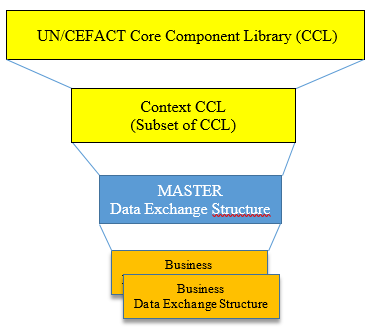UN/CEFACT Reference Data Models (RDM)
Author: UN Centre for Trade Facilitation and Electronic Business (UN/CEFACT)
Year of adopting/publication: 2017
Link to the document on the internet: ECE_TRADE_C_CEFACT_2017_11E__White_Paper_on_RDM_.pdf
Purpose: To facilitate flexible and interoperable exchange of real-time data throughout the supply chain.
Summary:
The United Nations Centre for Trade Facilitation and Electronic Business (UN/CEFACT) has developed for several decades base semantic standards to ensure end to end supply chain facilitation. These include the United Nations Trade Data Element Directory (UNTDED), the United Nations Electronic Data Interchange for Administrations, Commerce and Transport (UN/EDIFACT), the UN/CEFACT Core Component Library (UN/CCL), a series of code lists, business process models and message schemas.
UN/CEFACT has the aim to be the semantic hub for all electronic data requirements in the international supply chain. The UN/CCL and code lists cover all sectors of activities including materials management, commercial, logistics, transport, agriculture, health, insurance, finance, payments, customs… They are truly useful tools and provide an encyclopedia of semantic information that anyone can use free of charge.
However, like an encyclopedia, it may not always be easy to find the exact information that is needed for a single procedure. UN/CEFACT has therefore created subsets of this information similar to a single volume of an encyclopedia which is dedicated to a single sector of activity called a Reference Data Model (RDM).
Therefore, an RDM provides a consolidated list of standardized data and processes for use in a particular business domain, which are globally understandable and exchangeable between parties using common standard data exchange structures.
An RDM is an abstract model that organizes Business Information Entities (BIEs) and standardizes how they relate to one another and to the real world. The model provides a standard means by which data may be described, categorized and shared. An RDM can be employed whenever business information is being shared or exchanged amongst and between enterprises, governmental agencies, and/or other organizations in an open, worldwide environment.
The users of an RDM achieve interoperability of business information. This interoperability covers both interactive and batch exchanges of business data between applications through the use of the Internet and web-based information exchanges as well as traditional Electronic Data Interchange (EDI) systems. The business information in an RDM is ideally represented in both human-readable and machine-processable forms.
The content of an RDM contains the following (see Figure 1):
- Data Descriptions: For an RDM, the data descriptions, such as the BIEs mentioned earlier, are taken from the United Nations Core Components Library (UN/CCL) which provides a means to uniformly describe data, thereby supporting its searchability, identification and sharing;
- Data Context: This information for the RDM is taken from the Context subset of the UN/CCL (called the Context CCL) which provides formal descriptions of the specific business circumstances under which data will be used based on a set of Context Categories, which allow different business circumstances to be uniquely distinguished; and
- Data Sharing: Within an RDM, the “rules” for data sharing are established by the Master Data Exchange Structure and Business Data Exchange Structures. These supports the access and exchange of data where “access” consists of ad hoc requests (such as a query to a data asset); and “exchange” consists of fixed, recurring transactions (standard data exchange structures) between parties.

Benefits of UN/CEFACT Reference Data Models
- Semantic interoperability of data
- Reduction of costs
- Supporting Single Window
- Supporting United Nations Layout Key “Master Form principle”
- Providing links to the United Nations Trade Data Element Directory
- Supporting subsetting of international recommended code lists
- Common basis for code lists
- Syntax neutral
- Common basis for standardizing data
